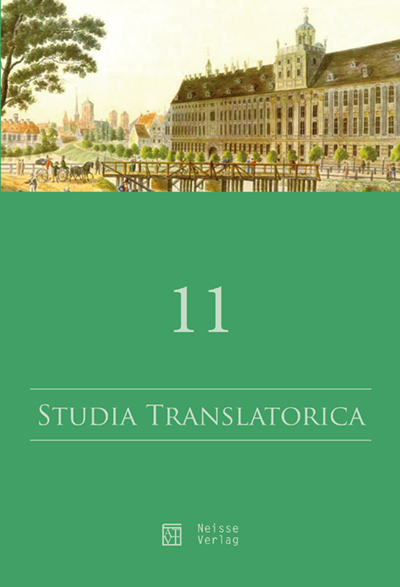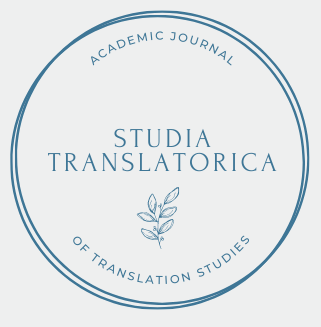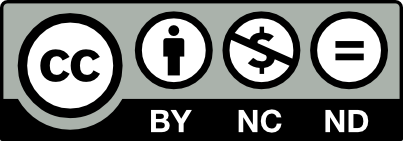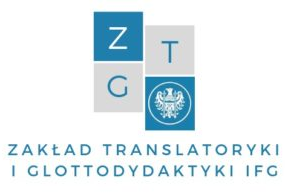
Studia Translatorica
Issue 11 (2020): Wielowymiarowość rzeczywistości translacyjnej. Mehrdimensionalität der Translationswirklichkeit. Multidimensionality of translation reality
Edited by: Anna Małgorzewicz
Der indirekten Translation auf der Spur – „Koelie“ von Madelon Székely-Lulofs in polnischer Übersetzung / On the trail of the indirect translation – “Koelie” written by Madelon Székely-Lulofs rendered into Polish
DOI: 10.23817/strans.11-1 (published online: 2020-11-01)
Received: 2020-06-07
Accepted: 2020-07-11
Keywords: indirect translation, literary translation, third culture elements, translation technique, rendering
The present article deals with the indirect translation, which is conceived by many translation theoreticians as an inadvisable practice. The aim of the paper is to prove that the Polish rendering of the novel “Koelie” by the Dutch writer Madelon Székely-Lulofs is in fact an indirect translation. The case study draws on a triangulation method consisting of peritextual, epitextual and comparative analysis. The epitextual analysis enabled to advance a hypothesis, that the translator of the novel into Polish – Herminia Bukowska – might have rendered indirect either via the German or English version. On the basis of the comparative analysis of the source text with its renderings into German, English and Polish carried out with regard to the so-called third culture elements, was it possible to verify this hypothesis. The comparison revealed quite a few unambiguous similarities between the Polish and German rendering in the translators’ approach in relation to the mentioned translation units, which in turn differ from the source text.
Mediation als soziokulturelles Sprachhandeln im Begleitband zum Gemeinsamen europäischen Referenzrahmen für Sprachen / Mediation as sociocultural language action in the Companion Volume to the Common European Framework of Reference for Languages
DOI: 10.23817/strans.11-2 (published online: 2020-11-01)
Received: 2020-06-10
Accepted: 2020-09-06
Keywords: mediation, language mediation, Common European Framework of Reference for Languages, CEFR, Companion Volume
The Common European Framework of Reference for Languages (CEFR) had a lasting impact on all areas of foreign language teaching not only in Europe but also worldwide. Although activities and strategies of language mediation were already included in its action-oriented approach, no empirically developed scales and descriptors were made available for them. As a result, language mediation has found its way into European classrooms to different degrees in the last two decades. The Companion Volume with New Descriptors seems to close this gap by rendering the concept of mediation more precisely, on the one hand, and extending it, on the other hand. This article outlines and critically assesses the concept of mediation as developed in the CEFR Companion Volume, compared to the earlier concept.
Mediation im Fremdsprachenunterricht – die neuen Deskriptoren des Gemeinsamen europäischen Referenzrahmens für Sprachen zum Bereich Mediation und ihr Potenzial für den DaF-Unterricht an polnischen Schulen / Mediation in Foreign Language Teaching – The new CEFR descriptors for mediation activities and their potential for GFL teaching in Polish schools
DOI: 10.23817/strans.11-3 (published online: 2020-11-01)
Received: 2020-07-02
Accepted: 2020-09-05
Keywords: mediation, language mediation, Companion Volume, CEFR, foreign language teaching in Poland
The Companion Volume to the Common European Framework of Reference for Languages (CEFR), published in German translation in 2020, introduces new scales and descriptors that expand and clarify some of the key concepts of the CEFR. Mediation – one of four communication modes besides reception, production and interaction – is given a prominent role in foreign language teaching and learning processes. This article tries to outline the structure of the concept of mediation as developed in the Companion volume on the basis of the new descriptors, and to discuss it in the context of current program specifications for foreign language teaching in Poland. The aim is to explore the concept’s potential for institutional teaching of German as a foreign language in Polish schools.
Znaczenie ekwiwalencji tekstowo-normatywnej w przekładzie aktów prawnych i sposoby jej ustalania / The importance of text-normative equivalence in the translation of law acts and the ways of its determination
DOI: 10.23817/strans.11-4 (published online: 2020-11-01)
Received: 2020-04-18
Accepted: 2020-07-11
Keywords: translation studies, law language, specialist vocabulary, text-normative equivalence
In the article, the problem of text-normative equivalence has been addressed. It was introduced by W. Koller in 1979, but so far it has not been further developed in the literature. Preserving textual and normative equivalence is particularly important in the translation of law texts. Therefore, the question arises about the parameters of equivalence. The article shows that in law acts such objective parameters are the specific attendance and distribution of lexical resources. They allow for a precise establishment of normative equivalents in the target language.
Translation and terminological challenges encountered in the compilation of the English-Polish, Polish-English photogrammetric dictionary
DOI: 10.23817/strans.11-5 (published online: 2020-11-01)
Received: 2020-04-20
Accepted: 2020-07-17
Keywords: photogrammetric dictionary, terminology, glossary, equivalence, conceptual mismatches
This paper describes a terminology project aimed at creating a fully bilingual English-Polish, Polish-English photogrammetric dictionary that is targeted at both field and language experts. The dictionary includes terms, definitions, full names of terms and their abbreviations, indications of the field to which a term belongs, synonyms, cross-references to related concepts, grammatical information, and equivalents. The starting point for the dictionary was the photogrammetric terminology glossary compiled by Granshaw (2016) from texts published in the “Photogrammetric Record” magazine.
Dokonać niemożliwego, czyli o trudnościach w tłumaczeniu komiksu „Der Fönig” Waltera Moersa na język polski / To do the impossible thing – some translation problems in the Polish version of the German comic book “Der Fönig” by Walter Moers
DOI: 10.23817/strans.11-6 (published online: 2020-11-01)
Received: 2020-03-30
Accepted: 2020-07-11
Keywords: translation techniques, Walter Moers, untranslatability
The following article discusses some problems in the translation of the German comic book “Der Fönig” into Polish. The main concern is to define the semantic dominant of the source text correctly and to find any adequate translation possibilities of language phenomena, which could contribute to problems in the translator’s work. As the source text has not been translated into Polish yet, the author presents his own translation proposals of two problematic fragments of the German original.
Miejsce tłumaczenia w uczeniu (się) języka obcego w nowej podstawie programowej kształcenia ogólnego / The place of translation in learning a foreign language in the new core curriculum for general education
DOI: 10.23817/strans.11-7 (published online: 2020-11-01)
Received: 2020-05-10
Accepted: 2020-09-06
Keywords: foreign languages, German, didactics of translation, curriculum, translation
Modern didactics of foreign languages should be based not only on the training of communication competence, which allows to achieve the most important goal of learning – communication in a foreign language, but also on the training of translation competence, which gives wider possibilities for the use of language, e.g. in language mediation. Mediated communication is often more difficult, requiring trust, intercultural competence, understanding of otherness from all participants as well as the responsibility of intermediaries for the final outcome of communication. Anyone can be a “translator” in everyday situations.
Wielką czy małą literą, czyli o problemach ortograficznych w tłumaczeniu tekstów specjalistycznych na przykładzie języka polskiego i hiszpańskiego / Uppercase or lowercase, about the orthographic problems in Spanish-Polish specialized translation
DOI: 10.23817/strans.11-8 (published online: 2020-11-01)
Received: 2020-01-10
Accepted: 2020-09-06
Keywords: Spanish-Polish legal translation, capital letters, names, titles of legal acts
The aim of this article is to present the problem of capital letters from the perspective of Spanish-Polish legal translations. The focus of the article lies on the titles of legal acts because it allows to show the mutual relations between linguistic, legal and translatory norms. At the beginning the problem of capitalization is presented from a general point of view. This is followed by a contrastive analysis of orthographic rules in Spanish and Polish, which demonstrates visible differences between those two languages. Furthermore, the influence of the extralinguistic factors and the usage created by the community of practice (Wegner 1998) on the translation of specialized texts is explained.
Kultowy film a przekład – za i przeciw / Film classics versus translation – pros and cons
DOI: 10.23817/strans.11-9 (published online: 2020-11-01)
Received: 2020-04-04
Accepted: 2020-07-11
Keywords: audiovisual translation, film translation, film classic, Sara
This article is devoted to the translation of the film “Sara” done using the voice-over technique and subtitles. The analysed film is one of the Polish classic film productions of the ‘90s. The peculiar character of film dialogues requires that the translator adopts translation techniques which do not conform with technical requirements for selected techniques that are applied in audio-visual translation. The viewer needs to have additional competences including the knowledge of linguistic norms, cinematographic traditions, customs, etc., in order to get a proper understanding of a specific scene.
A relevance-theoretical approach to “King Stakh’s Wild Hunt”: translating the Belarusian language and culture
DOI: 10.23817/strans.11-10 (published online: 2020-11-01)
Received: 2020-03-30
Accepted: 2020-07-27
Keywords: Belarusian, Karatkievich, King Stakh’s Wild Hunt, Relevance Theory, translation
This paper takes a relevance-theoretical approach to the English translation of “Дзікае паляванне караля Стаха” (1964), the Belarusian novel written by Uladzìmìr Karatkevìč – “King Stakh’s Wild Hunt” (translated by Mary Mintz, 1989). In doing so, it proposes a different perspective on the alleged ‘untranslatability’ of minority literature. The analysis takes into account various procedures applied to the different elements of the novel and reveals that Mintz makes strategic choices aimed at choosing the best solution for each problem individually.
Von den übersetzungswissenschaftlichen Ansätzen bis zum beruflichen Bewusstsein der künftigen Übersetzer. Einige Bemerkungen am Beispiel der Typologie von Übersetzungsverfahren nach Ulrich Kautz / From translation theories to the future translators’ professional awareness. Some remarks related to the typology of translation techniques by Ulrich Kautz
DOI: 10.23817/strans.11-11 (published online: 2020-11-01)
Received: 2020-05-13
Accepted: 2020-07-11
Keywords: university education, German studies, translation theory and practice, translation techniques
The paper is devoted to selected issues related to the strategies and procedures used in the translation process. It considers the description of the selected classification, i.e. the typology of translation techniques according to Ulrich Kautz, illustrated by numerous examples. The considerations include an evaluation by bachelor students of the Department of German Studies at the University of Rzeszów, concerning the identification/ selection/ application/ verification of translation strategies and techniques in the practical training of translation efficiency and mastering new vocabulary in a given subject area.
Alle Wege führen nach Rom? Die Entscheidungen des Übersetzers Olaf Kühl am Beispiel des Romans „Wie ich Schriftsteller wurde. Versuch einer intellektuellen Autobiographie“ von Andrzej Stasiuk / All roads lead to Rome? Olaf Kühl’s translatory decisions on the example of the novel “How I became a writer: an attempt at an intellectual autobiography”
DOI: 10.23817/strans.11-12 (published online: 2020-11-01)
Received: 2019-12-09
Accepted: 2020-07-11
Keywords: translation, translations strategies, culture translation, Polish literature
This article discusses the strategies that may be used during the process of translation of a literary work. It will be shown that the translators’ choices are context driven. The starting point for an analysis are four theoretical approaches to translation strategies (Markovina 1993, Koller 2004, Gercken 1999 and Hejwowski 2006). The analysis of the translator’s choices will be carried out at the example of Andrzej Stasiuk’s novel “Jak zostałem pisarzem. Próba autobiografii intelektualnej” translated into German by Olaf Kühl.
Syntactic complexity as a stylistic feature of subtitles
DOI: 10.23817/strans.11-13 (published online: 2020-11-01)
Received: 2020-03-23
Accepted: 2020-07-27
Keywords: translation style, stylometry, subtitles, syntactic complexity, corpus approaches
In audiovisual translation, stylometry can be used to measure formal-aesthetic fidelity. We present a corpus-based measure of syntactic complexity as a feature of language style. The methodology considers hierarchical dimensions of syntactic complexity, using syllable counting and dependency parsing. The test material are dialogues of several characters from the TV show “Two and a Half Men”. The results show that characters do not differ syntactically among themselves as much as might be expected, and that, despite a general tendency to level differences even more in translation, the changes in syntactic complexity between the original and translation depend mostly on the respective character-feature combination.
Linguistic aspects of subjectivity in song translation (in the light of Wojciech Młynarski’s works and self-referential remarks)
DOI: 10.23817/strans.11-14 (published online: 2020-11-01)
Received: 2019-12-01
Accepted: 2020-07-27
Keywords: subjectivity of translation, song translation, translator’s individual style, Wojciech Młynarski as a translator, equivalence levels’ hierarchy in translation
The article discusses the manifestations of subjectivity in the translation of songs created by Wojciech Młynarski, one of the best-known Polish songwriters of the second half of the 20th century. His personalized translation strategies have been presented on examples of Polish translations of the lyrics written by Irving Berlin, Vladimir Vysotsky and Bobby McFerrin. The analyses have shown that Młynarski gave absolute priority to three aspects of translation: prosodic equivalence; equivalence of intentional meaning (pragmatic equivalence) and comparability of the recipients’ aesthetic experiences. Wherever possible, the translator sought equivalence at the lexical-semantic level or at the imaging level, for example, he searched for lexemes or idioms that would evoke a picture similar to the original. However, if it was impossible to reproduce literal meanings or images in the target language, he focused on the three priorities listed above, leaving the other aspects of the original song in the far background.
Literarische Einbettung von Fachsprachlichkeit als Herausforderung für den Übersetzer [Wienen, Ursula (2017): „Translation von Fachsprache in literarischen Texten. Ein deutschromanischer Vergleich“. (Hermeneutik und Kreativität. Band 5) St. Ingbert: Röhrig Universitätsverlag. 490 S.]
DOI: 10.23817/strans.11-15 (published online: 2020-11-01)
Received: 2020-03-18
Accepted: 2020-07-11
Keywords:
Karl Dedecius‘ Herangehensweise an literarische Texte. Die Lyrik von Tadeusz Różewicz in deutscher Übersetzung [Czechowska, Ilona (2018): „Sprachliche Bilder in den Übersetzungen der Lyrik von Tadeusz Różewicz durch Karl Dedecius“. Dresden: Neisse Verlag. 312 S.]
DOI: 10.23817/strans.11-16 (published online: 2020-11-01)
Received: 2020-03-15
Accepted: 2020-07-11
Keywords:
Fantinuoli, Claudio (Hg.) (2018): Interpreting and technology. (Translation and Multilingual Natural Language Processing 11). Berlin: Language Science Press. 149 S.
DOI: 10.23817/strans.11-17 (published online: 2020-11-01)
Received: 2020-03-31
Accepted: 2020-07-11
Keywords:


